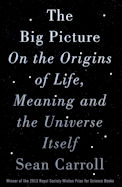The latest batch:
Sunday, 26 January 2025
Saturday, 18 January 2025
book review: The Big Picture
The Big Picture: on the origins of life, meaning and the universe itself.
Oneworld. 2016
In this ambitious work, Carroll covers an enormous range: fundamental physics, cosmology, epistemology, complexity, consciousness, morality.
He shows how (our best current understanding of) fundamental physics allows no room for any ghosts in the machine. He explains the philosophical position of “poetic naturalism”, and how it can be used to tell (well-founded, scientific) “stories” about the emergent macro-world that don’t need to reduce everything to quantum physics, but how this necessarily means we have to omit certain aspects when telling these stories. And he introduces Bayesian reason as a technique for improving understanding at all levels.
This is a bold endeavour, cramming much profound material into 50 chapters, each less than 10 pages, but adding up to over 400 pages of fascinating material. He has interesting insights on a wide range of topics, not just his own speciality of quantum physics, but also epistemology, emergence, complexity, and more. It is a deeply humanistic account, yet grounded in the cold hard light of the constraints of physical reality.
Highly recommended.
Saturday, 11 January 2025
out of this world problems
Jupiter has been prominent recently. We observed it using our SeeStar telescope. It was a visible disc, but a bit small, with faint bands juuuust visible.
Last night was clear, so we decided to try using the big telescope in the dome to get a better view.
Last night was cold. The dome was frozen shut. Oh well.
Monday, 6 January 2025
Raman SOM
Daniel West, Susan Stepney, Y. Hancock. Unsupervised self-organising map classification of Raman spectra from prostate cell lines uncovers substratified prostate cancer disease states. Scientific Reports, 15:773, 2025. doi:10.1038/s41598-024-83708-6
This started out as a feasibility study, to see if Kohonen Self-Organising Maps (SOMs) could be used to cluster minimally preprocessed Raman spectroscopy data taken from individual cells. SOM an unsupervised learning approach, and can cluster high dimensional data (here, over 1000D) down into a 2D visual representation. We had Raman spectra of prostate cells, some cancerous, some not. Could a SOM distinguish these two classes?
We blinded the data, so that the system did not know which spectrum was in which class, to ensure this was truly an unsupervised exercise. After some fiddling about to understand what values several parameters should be, we fed the data in, and looked at the resulting map. We could see three clusters.
Had it worked? We unblinded the data, and yes, one of the clusters was the non-cancerous cells, and the other two clusters were cancerous cells. Why two clusters? Well, it turns out the mapping process had managed to discover two distinct classes of cancerous cells. Further research is underway to investigate these differences.
So yes, it works, and better than we had hoped!

